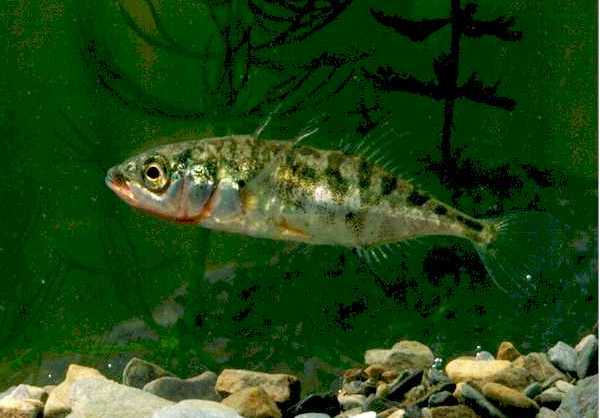Gasterosteus aculeatus - Three-spined Stickleback
Phylum: Chordata - Class: Actinopterygii - Order: Gasterosteiformes - Family: Gasteroteidae

The three-spined stickleback is very common in British rivers, canals and lakes. In rivers, in particular, it is a fish of the slow-flowing lowland reaches, but because of its habit of colonising tiny bays and backwaters it is sometimes able to thrive in surprisingly swift streams.
In spring the male Stickleback develops a red throat and belly (the male in the picture is a few weeks away from full spawning colours) and it builds a nest from vegetation beside the bank. Sticklebacks usually spawn in May and June. The adults look after their eggs and protect the young larval fish during their first few days of life - an unusual trait for a fish.
The British record 3-spined Stickleback weighed just 4drm; it was caught by Dennis Flack in Cambridgeshire in 1998
Ten-spined stickleback
At just three or four centimetres when fully grown, the tiny ten-spined stickleback (Pungitius pungitius), is another common species in the north and Britain's freshwater fishes and is most often found in the brackish water of river estuaries or in weedy ponds and ditches.
Excited at the prospect of flyfishing? So are we, and we're pretty sure you would find the Winding River Mystery trilogy of action-packed thrillers gripping reading too. Dead Drift, Dead Cert, and Dead End are Pat O'Reilly's latest river-and-flyfishing based novels, and now they are available in ebook format. Full details on our website here...
Buy each book for just £4.96 on Amazon...
Please Help Us: If you have found this information interesting and useful, please consider helping to keep First Nature online by making a small donation towards the web hosting and internet costs.
Any donations over and above the essential running costs will help support the conservation work of Plantlife, the Rivers Trust and charitable botanic gardens - as do author royalties and publisher proceeds from books by Pat and Sue.
